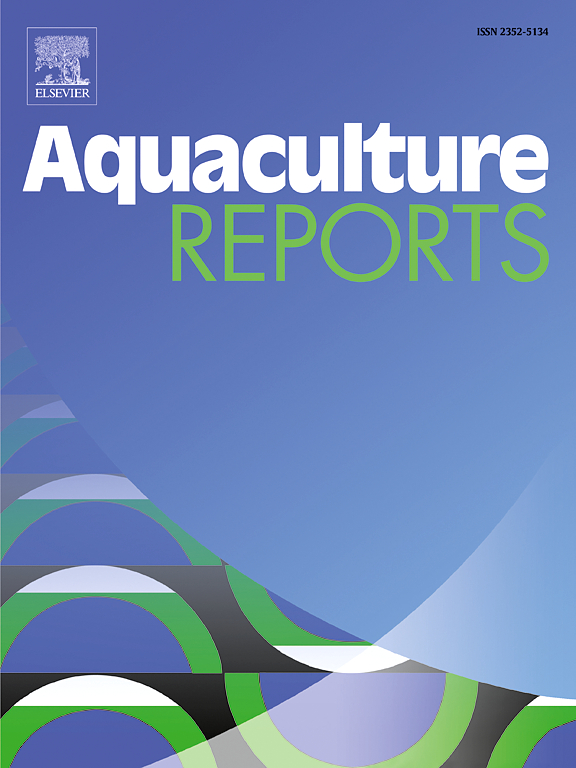亚洲红尾鲶鱼幼鱼有效磷需要量的研究
IF 3.7
2区 农林科学
Q1 FISHERIES
引用次数: 0
摘要
本试验旨在探讨亚洲红尾鲶鱼幼鱼饲料中有效磷的最佳需要量。分别投喂磷酸单钙添加水平为0.00 %、0.75 %、1.50 %、2.25 %和3.00 %的等氮(42.00 %)和等脂(9.00 %)饲料(即P0、P0.75、P1.5、P2.25和P3) 56 d。随着磷添加量的增加,鱼的增重率呈上升趋势,最高可达2.25 %。磷和钙的表观消化系数(ADC)以及全身和脊椎骨中磷和钙的含量与饲粮磷水平呈正相关,而肠道中磷转运和代谢相关基因的表达与饲粮磷水平的升高呈负相关。采用二次回归法,以增重为基础估算饲粮磷的最佳需要量为0.87%,以椎骨磷含量为基础估算饲粮磷的最佳需要量为0.99 %。P1.5、P2.25和P3组的全鱼粗脂肪含量和血清总胆固醇显著低于P0和P0.75组(P <; 0.05)。与P0组相比,P2.25组肝脂滴体积和数量明显减少。缺磷导致生长发育迟缓,骨矿化减少,全身组织和肝脏脂质积累增加。这些研究结果为在饲料中添加磷,优化生长和骨矿化,同时尽量减少饲料中过量磷提供了实用指导。本文章由计算机程序翻译,如有差异,请以英文原文为准。
Available phosphorus requirement of juvenile Asian red-tailed catfish (Hemibagrus wyckioides)
This study explored the optimal dietary available phosphorus (P) requirement for juvenile Asian red-tailed catfish (Hemibagrus wyckioides). Five isonitrogenous (42.00 %) and isolipidic (9.00 %) diets with monocalcium phosphate supplementation levels of 0.00 %, 0.75 %, 1.50 %, 2.25 %, and 3.00 % (namely P0, P0.75, P1.5, P2.25, and P3) were fed to fish for 56 d. Weight gain rate increased with phosphorus supplementation up to 2.25 % and then declined. The apparent digestibility coefficients (ADC) of phosphorus and calcium, as well as the phosphorus and calcium contents in the whole body and vertebrae, exhibited a positive correlation with dietary phosphorus levels, while the expression of intestinal genes related to phosphorus transport and metabolism showed a negative correlation with increasing dietary phosphorus levels. Using quadratic regression, the optimal phosphorus requirement was estimated at 0.87 % based on weight gain and 0.99 % based on vertebrae phosphorus content. Whole body crude lipid content and serum total cholesterol was significantly lower in P1.5, P2.25, and P3 compared to the P0 and P0.75 group (P < 0.05). Liver lipid droplet volume and number were markedly reduced in P2.25 compared to the P0 group. Phosphorus deficiency resulted in stunted growth, reduced bone mineralization, and increased lipid accumulation in whole-body tissue and the liver. These findings provide practical guidance for phosphorus supplementation in H. wyckioides aquaculture, optimizing growth and bone mineralization while minimizing excess phosphorus in feeds.
求助全文
通过发布文献求助,成功后即可免费获取论文全文。
去求助
来源期刊

Aquaculture Reports
Agricultural and Biological Sciences-Animal Science and Zoology
CiteScore
5.90
自引率
8.10%
发文量
469
审稿时长
77 days
期刊介绍:
Aquaculture Reports will publish original research papers and reviews documenting outstanding science with a regional context and focus, answering the need for high quality information on novel species, systems and regions in emerging areas of aquaculture research and development, such as integrated multi-trophic aquaculture, urban aquaculture, ornamental, unfed aquaculture, offshore aquaculture and others. Papers having industry research as priority and encompassing product development research or current industry practice are encouraged.
 求助内容:
求助内容: 应助结果提醒方式:
应助结果提醒方式:


